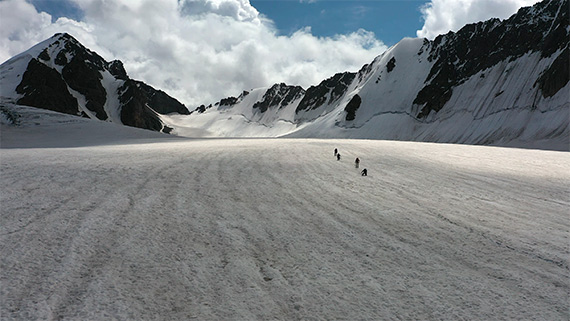A successful scientific expedition to Turgen-Aksu glacier in Tien Shan mountains, Eastern Kyrgyzstan

Environmental scientists around the world are in their quest for understanding the complex Earth system. Improved understanding of the system is the only way how we can predict and mitigate or adapt to the environmental changes happening in future. But how about the poorer countries that have an insufficient capacity to observe and monitor the environment surrounding them? Without the latest knowledge, expert skills and state-of-art instrumentation, their ability to deliver modern observations is less than limited. There are more than 8000 glaciers in Kyrgyzstan, but only 13 of them are being monitored. This is due to a lack of resources and narrowed expertise of the Kyrgyz scientists.
Therefore, the Ministry for Foreign Affairs of Finland decided to share the top-level experience Finland has gathered throughout the research performed at the Finnish Meteorological Institute and share such knowledge and expertise with the research institutes in Kyrgyzstan and Tajikistan. This effort has been funded through the development program organized by the Ministry, right now focusing on the countries in Central Asia. This capacity-building effort has been running about five years, with research campaigns and expeditions being arranged in Kyrgyzstan and Tajikistan as well as in Finland.
The latest scientific expedition was organized from July 28 until August 7, 2019. It targeted the Turgen-Aksu glacier located in the mountain range of Tien Shan, about 70 kilometers from the boarder of China. The glacier is about 6km2 large and it is an important source of water for the local people. Glacier meltwater is critical as a source of drinking water, hydropower as well as for the agriculture in this rural area. The melting glacier also possess a huge risk for the local communities living in the valley with increased flooding risks. Thus, it is of uttermost importance to understand the glacier behavior, in order to predict the changes that may occur in the future.
Three teams (Finnish, Kyrgyz and Tajik) participated in the expedition, using two working languages - English and Russian. The trip started in Bishkek, the capital of Kyrgyzstan. From Bishkek, the team travelled to the city of Karakol, the gate to the Eastern mountain range. From there, they continued by cars to a Kyrgyzhydromet avalanche station laying in the beginning of the valley heading to the glacier. From the station, the team continued by car through series of off-roads, before starting the 7 kilometers hike to the expedition base built in the glacier meadows 3374 m above sea level. Most of the carriage containing the food, personal stuff and the instrumentation was carried by horses throughout the rough terrain. There is no infrastructure on the way to the glacier, the entire area is in fact restricted and the team needed a special permission to enter the territory. The group walked about 8 kilometers every day to reach the ablation zone of the glacier ranging from 3500 m up to 3850 m above the sea level. Part of the team continued to the accumulation zone at 4165 m, the zone of the glacier which is not melting down and is covered by snow the entire year. Entering this area is impossible without a proper climbing equipment, since there are crevasses, the deep cracks in the ice presenting a huge risk for the research group.
The main mission of the expedition was to set up an automatic weather station below the glacier that will monitor different variables such as temperature, humidity, pressure, wind direction and speed, snow height, precipitation and solar radiation. There were no records on these different variables in the area until the station was set up. It is very important to have this data to be able to spot the changes and trends happening here throughout the years. The data from the station will also improve the forecasting services in the region.
The second mission of the expedition was the glacier mapping with drones to quantify changes to its surface area. There were three drones flying over the huge mass of ice, collecting the data that will be compared each year, so the scientists can determine the changes in the size of the glacier.
The expedition also measured the snow accumulated on the glacier (in snow water equivalent), as well as the amount of melt that had occurred since last year. This was done by measuring the pole height adjustment to stakes drilled into the ice the previous year. Together, the accumulation and the ablation will tell us a lot about the changes in the mass balance of the glacier. Some of the poles that were drilled in last year are now 4 metres exposed.
Last mission of the expedition was a collection of snow samples in the accumulation zone of the glacier. The snow samples were filtered in Kyrgyzstan and they will be later analyzed in the laboratory in Helsinki. The snow samples will tell us more about the black carbon and dust in the glacier's snow, thus determining the anthropogenic (human-caused) source of pollution in the local snow as well as the effect of natural air pollution (dust) on the glaciers' mass balance.
All these activities will help the Kyrgyz hydrometeorological institute to monitor the glacier and the weather surrounding it. The Kyrgyz and Tajik scientists have received from Finland new equipment (weather station, laptop, drone, etc.). They learned how to use the equipment and perform such monitoring and observations independently which improves their capability to deliver this very much needed observations and services for the environment and for their own people.
Further information:
Antti Wemberg, Project Manager, tel. +358 46 922 3117, antti.wemberg@fmi.fi
Magdalena Brus, Senior Communications Manager, tel. +358 504154 762, Magdalena.brus@icos-ri.eu
